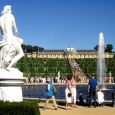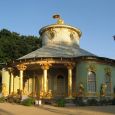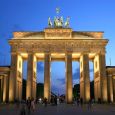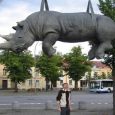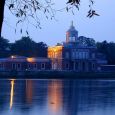Potsdam
Advertisement
By Air
Berlin has two airports which are not far away from Potsdam.From Tegel bus X9 connects to Jungfernheide S-Bahn station, from where you can take S42 to Westkreuz and then S7 to Potsdam for passengers to Charlottendorf or Medienstadt RE trains connect to the S7 at Wannsee.
By Train
Potsdam, included in the fare zone "C" (Tarifbereich C) of Berliner public transport area, is served by the S-Bahn lines S7 and S5, the latter only at night.The stations served are Griebnitzsee, Babelsberg and the Hauptbahnhof, the main and long-distance station of the city.Other DB stations in Potsdam are Charlottenhof, Park Sanssouci (including the monumental Kaiserbahnhof), Medienstadt Babelsberg (formerly Drewitz), Rehbrücke and Pirschheide.The city also counts a 27 km-long tramway network.
By Road
Potsdam is served by the motorways A10, a beltway better known as Berliner Ring, A115 (using part of the AVUS) and is closely linked to A2 and A9.The National Roads B1 and B2 cross the city. Potsdam counts a network of urban and suburban buses and trolleybuses.
Sanssouci Palace
Sanssouci is the name of the former summer palace of Frederick the Great, King of Prussia, in Potsdam, near Berlin.It is often counted among the German rivals of Versailles. While Sanssouci is in the more intimate Rococo style and is far smaller than its French Baroque counterpart, it too is notable for the numerous temples and follies in the park.The palace was designed by Georg Wenzeslaus von Knobelsdorff between 1745 and 1747 to fulfill King Frederick's need for a private residence where he could relax away from the pomp and ceremony of the Berlin court.The palace's name emphasises this; it is a French phrase (sans souci), which translates as "without concerns", meaning "without worries" or "carefree", symbolising that the palace was a place for relaxation rather than a seat of power.The palace is little more than a large single-storey villa—more like the Chateau de Marly than Versailles.Containing just ten principal rooms, it was built on the brow of a terraced hill at the centre of the park.
Orangery Palace
is also known as the New Orangery on the Klausberg, or just the Orangery. It was built by the Romantic on the Throne, Friedrich Wilhelm IV, in his seat of Potsdam, Brandenburg, Germany, from 1851 to 1864.The construction of the Orangery Palace began after preliminary drawings by Friedrich Wilhelm IV. The architects Friedrich August Stüler and Ludwig Ferdinand Hesse were commissioned to turn the drawings into a reality.The building, with its 300 meter long front, was built in the style of the Italian Renaissance, after the image of the Villa Medici in Rome and the Uffizi in Florence.The Norse and Sicilian Gardens lie to the east. These completely different garden sections were laid out by Lenné between 1857 and 1860. The dark, effective Norse Garden, with its pines, was to have been an element of the planned triumph street.
Chinese Tea House
is a garden pavilion in Sanssouci Park in Potsdam. Frederick the Great had it built, about seven hundred meters southwest of the Sanssouci Summer Palace, to adorn his flower and vegetable garden. The garden architect was Johnn Gottfried Büring, who between 1755 and 1764 designed the pavilion in the then-popular style of Chinoiserie, a mixture of ornamental rococo elements and parts of Oriental architecture.The cupola crowning the roof is surmounted by a gilded Chinese figure with an open parasol. Friedrich Jury created it in copper after a design by the sculptor Benjamin Giese. Light falls into the central chamber through the long oval window openings of the cupola as it does through the windows in the facade.
Brandenburg Gate
is a former city gate and one of the main symbols of Berlin and Germany.It is located west of the city centre at the junction of Unter den Linden and Ebertstraße, immediately west of the Pariser Platz.It is the only remaining gate of a series through which Berlin was once entered.One block to the north stands the Reichstag building.The gate is the monumental entry to Unter den Linden, the renowned boulevard of linden trees which formerly led directly to the city palace of the Prussian monarchs. It was commissioned by King Frederick William II of Prussia as a sign of peace and built by Carl Gotthard Langhans from 1788 to 1791. Having suffered considerable damage in World War II, the Brandenburg Gate was fully restored from 2000 to 2002 by the Stiftung Denkmalschutz Berlin (Berlin Monument Conservation Foundation).Today, it is regarded as one of Europe's most famous landmarks.
Biosphare Potsdam
is an indoor tropical botanical garden located in the Volkspark Potsdam, a park between the Sanssouci Park and the Neuer Garten Potsdam (New Garden) at Georg-Hermann-Allee 99, Potsdam, Brandenburg, Germany. It is open daily; an admission fee is charged.The garden contains approximately 20,000 tropical plants representing about 350 species, including orchids, epiphytes, and trees about 14 meters in height, including a palm grove and mangrove swamp. It also includes tropical crops, a waterfall, two lakes, and various types of tropical wildlife, including iguanas, snakes, spiders, frogs, geckos, and pheasants, as well as a butterfly house containing about 30 butterfly species.
Einstein Tower
is an astrophysical observatory in the Albert Einstein Science Park in Potsdam, Germany built by Erich Mendelsohn. It was built on the summit of the Potsdam Telegraphenberg to house a solar telescope designed by the astronomer Erwin Finlay-Freundlich. The telescope supports experiments and observations to validate (or disprove) Albert Einstein's relativity theory. The building was first conceived around 1917, built from 1919 to 1921 after a fund-raising drive, and became operational in 1924. Although Einstein never worked there, he supported the construction and operation of the telescope. It is still a working solar observatory today as part of the Potsdam Astrophysical Institute. Light from the telescope is directed down through the shaft to the basement where the instruments and laboratory are located.
Marmorpalais
was a royal residence in Potsdam, eastern Germany, built on the grounds of the extensive Neuer Garten on the shores of Lake Heiliger See.The palace was commissioned by Frederick William II of Prussia and designed in the early classicist style by the architects Carl von Gontard and (from 1789) Carl Gotthard Langhans, designer of Berlin's Brandenburg Gate.The Marmorpalais was reserved for the private use of the king, who had an artistic temperament. With this new construction the nephew and successor of Frederick the Great dissociated himself from his childless uncle, whom he disliked and who favored earlier Baroque and Rococo forms.
Information not available


